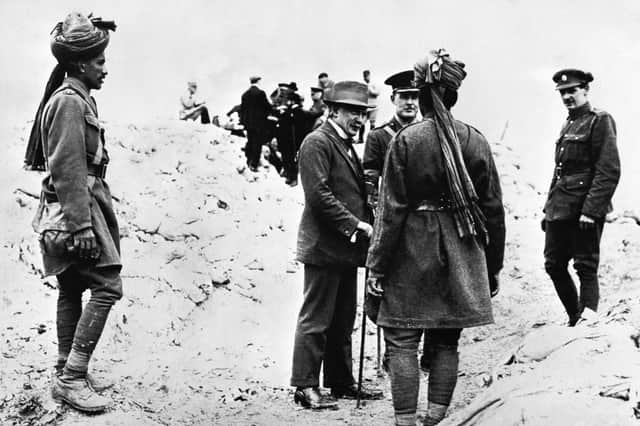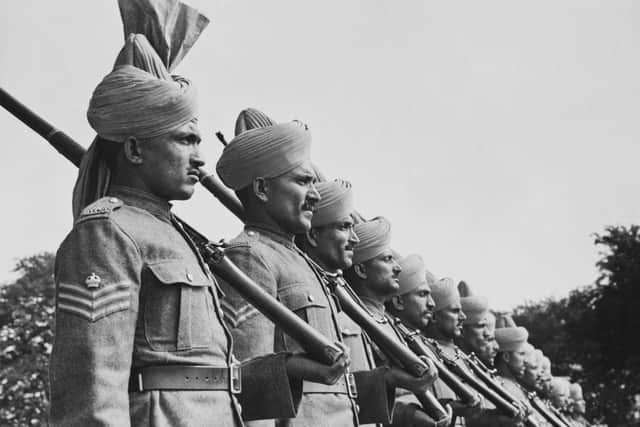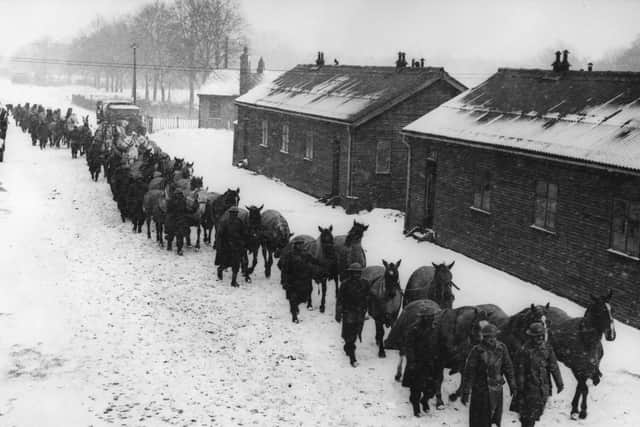Racism in Scotland: A memorial to British Indian Army soldiers who served in World Wars would help counter far-right's hate – Dr Saqib Razzaq


That is something that the charity Colourful Heritage is planning to change, with plans now well underway for a memorial in Glasgow to our forgotten soldiers.
More than four million of them fought alongside British troops in the 20th century conflicts, with many making the ultimate sacrifice.
Advertisement
Hide AdAdvertisement
Hide AdScotland has a special connection to the British Indian Army (BIA) through a Second World War regiment called Force K6.
It was a mule transport corps which first arrived in Marseilles in December 1939 to join the war effort, before being later evacuated out of Dunkirk.
They spent the next three-and-a-half years in the UK, and were moved to Scotland to train with British infantry brigades.
Some of the young soldiers died while training in harsh conditions in the Highlands and the north-east and are buried here after dying from accidents on exercise, tuberculosis, or other illnesses.
Nine are buried at Kingussie, which is the single largest graveyard in the UK where Force K6 soldiers are laid to rest, and others are buried in Aberdeenshire, Sutherland, and Banffshire. The youngest was Mushtaq Ahmad, aged just 21.


These soldiers were primarily from the Punjab region and Khyber Pakhtoonkhwa in present-day Pakistan, who answered the urgent call made to the Indian empire to come to France to help the allies.
Today, the George Square Cenotaph in Glasgow represents the Christian community well through a crucifix affixed to the monument, but other religious groups have no permanent memorial.
Scotland has a diverse history, and we can do more to tell that story and give people a sense of belonging.
Advertisement
Hide AdAdvertisement
Hide Ad

The BIA was made up of people of many faiths and a range of nations – Hindus, Muslims, Sikhs, Christians, Gurkhas and more fighting alongside British troops, with more than 160,000 soldiers losing their lives.
In recent years, thanks to the work of Colourful Heritage and the support of many MSPs, recognition of their contribution has increased.
In 2018, a multi-faith remembrance service was held in Kingussie, where an Islamic prayer and an Armed Forces blessing took place at the gravesides.
The graves have been tended to for decades by an elderly local woman, Isobel Harling, who last year was awarded the British Empire Medal in recognition of her dedication.
Legion Scotland, Poppyscotland and the Royal British Legion have all been leading a growing movement to remember how the Commonwealth answered the call for volunteers.
And the Commonwealth War Graves Commission’s report on Historical Inequalities in Commemoration highlighted the immediate need to rectify the lack of recognition of the contribution of the BIA.
But it remains the case that there is no permanent memorial to the incredible contribution. It’s time for that to change.
The scale of the BIA contribution cannot be overlooked. In the First World War, there were 1.5 million servicemen and a total of 74,000 died with up to 100,000 injured.
Advertisement
Hide AdAdvertisement
Hide AdIn the Second World War, there were 2.5 million servicemen – 87,000 died and up to 150,000 were injured.
They provided supplies valued at £479 million in the First World War – around £25 billion in today’s money – and £1.3 billion in the Second World War – £53 billion in today’s money.
A memorial working group has now been established to address the lack of recognition, made up of MSPs, Armed Forces representatives and others.
But this project is about the entire community, so we have engaged with primary and secondary schools to educate young people about the contribution of the BIA and encouraged them to submit designs.
Schools which took part included Giffnock Primary School, Kirkhill Primary and Woodfarm High in East Renfrewshire and St Andrew’s Primary in Cumbernauld.
More than 80 brilliant ideas for a memorial were received, and we will now work with an artist to finalise a detailed design this year.
In the months ahead, we will formally submit proposals to Glasgow City Council, with possible site locations including either Kelvingrove Park or George Square.
The memorial will commemorate the past, but also serve as a reminder for the future.
Advertisement
Hide AdAdvertisement
Hide AdIt will show children in Scotland from all faiths and backgrounds that they have a stake in our country’s history and values.
We know that many people from South Asian backgrounds in Scotland face racism on a daily basis. There is a narrative from the far right that they don’t belong here.
A permanent memorial will show today’s generation of young people – from all backgrounds – that we have a shared past and we have a shared future.
Coupled with that is the need to embed knowledge of the contribution of the South Asian community in Scotland into our education curriculum.
We have created a primary school resource pack which not only highlights the role of the BIA and Force K6, but also illustrates Scotland’s South Asian contribution to entrepreneurship, political participation and Glasgow’s multicultural history.
With suggested lesson plans and discussion points, this resource helps teach children about a lesser-studied element of Scottish culture, and we hope to see more schools use it in the years ahead.
For over 300 years, there have been people from all over South Asia arriving on Scotland’s shores to build new lives.
The South Asian-Scotland migration story is an inspiring narrative of community, identity and tolerance which children will carry with them for years to come.
Advertisement
Hide AdAdvertisement
Hide AdAnd if they are ever asked “what have South Asian migrants ever done for Britain?”, they have the answer.
They will be able to point to a permanent memorial and explain how brave soldiers from modern-day Pakistan, India and Bangladesh came to Britain’s aid in its hour of need, and fought gallantly for our country.
Dr Saqib Razzaq is project officer and head of research at Colourful Heritage
A message from the Editor:
Thank you for reading this article. We're more reliant on your support than ever as the shift in consumer habits brought about by coronavirus impacts our advertisers.
If you haven't already, please consider supporting our trusted, fact-checked journalism by taking out a digital subscription.
Comments
Want to join the conversation? Please or to comment on this article.
